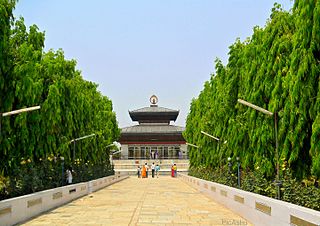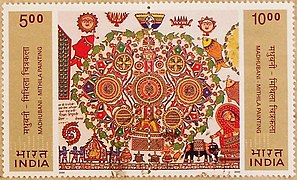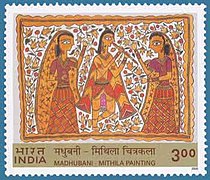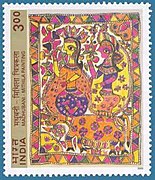
Madhubani is a City Municipal Corporation and headquarter of Madhubani district. Madhubani is situated in the Indian state of Bihar. It comes under Darbhanga Division. It is situated at 26 km northeast of Darbhanga City. The Madhuban Raj in Madhubani was created as a consequence. The word "Madhuban" means "forest of honey", from which Madhubani is derived, but sometimes it is also known as "madhu"+"vaani" meaning "sweet" "voice/language".

Madhubani district is one of the thirty-eight districts of Bihar, India, and is a part of Darbhanga division. Its administrative headquarters are located in Madhubani. The district has an area of 3,501 square kilometres (1,352 sq mi) and has a population of 4,487,379.
Maithils, also known as Maithili people, are an Indo-Aryan ethno-linguistic group from the Indian subcontinent, who speak the Maithili language as their native language. They inhabit the Mithila region, which comprises Northern and Eastern Bihar and Northeastern Jharkhand in India and some adjoining districts of Nepal constituting Madhesh Province in addition to some terai districts of Bagmati and Koshi Provinces. The Maithil region forms an important part of Hinduism as it is said to be the birthplace of Sita, the wife of Ram and incarnation of Lakshmi.

Mithila, also known as Tirhut, Tirabhukti and Mithilanchal is a geographical and cultural region of the Indian subcontinent bounded by the Mahananda River in the east, the Ganges in the south, the Gandaki River in the west and by the foothills of the Himalayas in the north. It comprises certain parts of Bihar and Jharkhand of India and adjoining districts of the Koshi Province, Bagmati Pradesh and Madhesh Province of Nepal. The native language in Mithila is Maithili, and its speakers are referred to as Maithils.
Mithila culture or Maithil culture refers to the culture which originated in the Mithila region of the Indian subcontinent. Mithila comprises Tirhut, Darbhanga, Kosi, Purnia, Munger, Bhagalpur and Santhal Pargana divisions of India and adjoining provinces of Province No. 1, Bagmati Pradesh, and Madhesh Province of Nepal.
Bihari culture refers to the culture of the Indian state of Bihar. Bihari culture includes Angika culture, Mithila culture, Bhojpuri Culture and the culture of Magadha.

The National Handicrafts and Handlooms Museum (NHHM) commonly known as National Crafts Museum in New Delhi is one of the largest crafts museums in India. It is run by the Ministry of Textiles, Government of India. The museum is situated on the corner of the Pragati Maidan, facing the Purana Quila complex. In 2015, the Government of India announced that a Hastkala (handicrafts) Academy would be established in the museum premises, converting some galleries into classrooms. Initial renovations destroyed one of the museum's most well-known artifacts, a room of murals painted by Madhubani artist Ganga Devi, leading to widespread criticism. As of 2019, renovations are still ongoing.

Manjushas are an Indian art form. They are temple-shaped boxes comprising eight pillars. They are made of bamboo, jute, and paper. They also contain paintings of Hindu gods and goddesses and other characters. These boxes are used in Bishahari puja, a festival dedicated to the Snake God that is celebrated in Bhagalpur and nearby regions, India.

Mahasundari Devi was an Indian artist and Madhubani painter. She was awarded the Tulsi Samman by the Government of Madhya Pradesh in 1995, and in 2011 she received the Padma Shri award from the Government of India.
Ganga Devi was an Indian painter, considered by many as one of the leading exponents of Madhubani painting tradition. She is credited with popularizing the Madhubani painting outside India. She was born in 1928 in Mithila in the Indian state of Bihar in a Kayastha family and took to the traditional painting craft, specialising in the kachni style. She traveled abroad with her art and was a part of the Festival of India in the United States, which yielded a number of paintings under the title, America series, including Moscow Hotel, Festival of American Folk Life, and Ride in a Roller Coaster. The Government of India awarded her the National Master Craftsman Award and followed it up with the fourth highest civilian award of Padma Shri in 1984.
Bharti Dayal is an Indian artist who specializes in Madhubani art.
Godawari Dutta is an Indian painter, well known for Madhubani Painting and patron of Mithila Kala Vikas Samiti. She was awarded India's fourth highest civilian award the Padma Shri.

Baua Devi is a Mithila painting artist from Jitwarpur village of Madhubani District in Bihar. Mithila painting is an ancient folk art that originated in the region. It is recognized as a series of complex geometric and linear patterns traced on the walls of a house's inner chambers. It was later transferred to handmade paper and canvases. Baua Devi won the National Award in 1984 and received the Padma Shri in 2017.

Dulari Devi is an Indian artist and illustrator, working in the Mithila art tradition. In 2021, she was a recipient of the Padma Shri, a civilian honour granted by the Government of India, for her contributions to art.
Karpoori Devi was an Indian folk artist, painting in the Madhubani art tradition and creating textile art in the Sujni tradition. She belonged to an early generation of artists who sold Madhubani art with critical and commercial success, and her work has been archived in collections in India as well as Japan, Australia, and the United States of America.
Ambika Devi is an Indian artist, who works in the Madhubani art tradition. In 2009, she received the National Handicrafts Award for her contributions to art.
Bihar is a state in eastern India divided by the Ganges river, an area which was once an important center for culture and learning. A Neolithic settlement has been discovered at Chirand which contains rock paintings similar to those found in Spain's Altamira and France's Lascaux regions. The tradition of painting has been handed down from generation to generation in the families of the Mithila and Bhojpur regions mainly by women. Painting was usually done on walls during festivals, religious events, and other milestones of the life cycle, like birth, Upanayanam, and marriage. Other styles of this region include Tikuli, Manjusha, and Patna kalam.
Sita Devi (1914–2005) was an Indian artist, specializing in painting in the Madhubani tradition. She is one of the most well-known Madhubani artists from India, and was one of the first to receive national recognition for the art form, receiving a number of awards for her work including the Padma Shri in 1981, as well as the Bihar Ratna Samman in 1984. She was influential in activism for local development in her village of Jitwarpur, in the state of Bihar, and taught Madhubani art to local residents, especially women, during her career in an effort to encourage financial stability. Her paintings have been praised for their individual style, particularly their use of color, have been widely exhibited, and are archived in India as well as in museums in France, the United States, the United Kingdom, and Japan.
Subhadra Devi is a Mithilia artist from Bihar and known for Madhubani Painting and patron of Mithila Kala Vikas Samiti. She is awarded India's fourth highest civilian award the Padma Shri in 2023.
Upendra Maharathi was an Indian artist who worked in various mediums including painting, sculpture, illustration, architecture, graphic design, and textile design. He was born in the village of Narendrapur in Odisha and received his art education at the Government College of Art & Craft in Kolkata under Mukul Dey and Percy Brown. After completing his studies, he settled in Bihar. His more than 900 works have been preserved by the National Gallery of Modern Art, Delhi.












